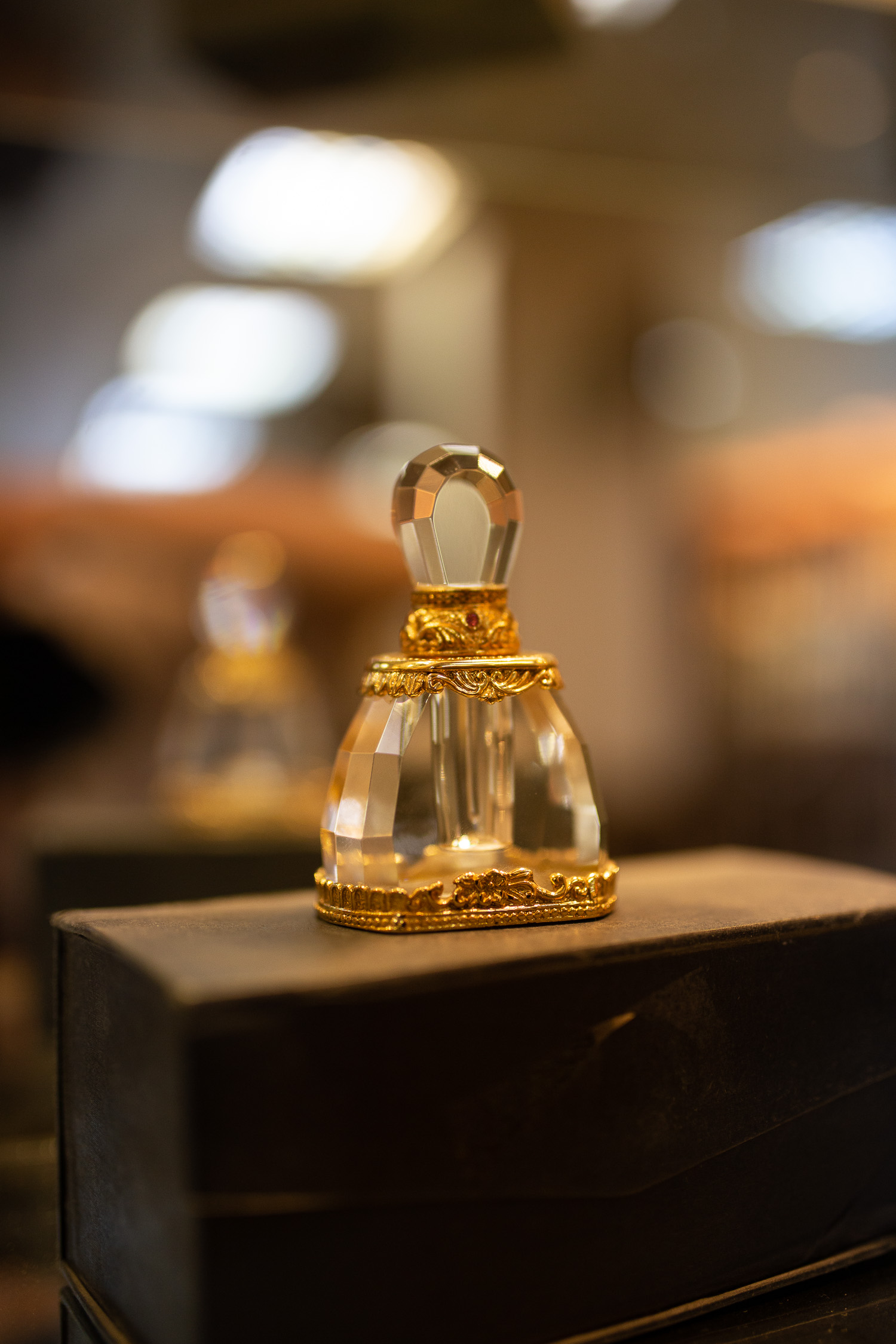ANCIENT EGYPTIAN PERFUMES
ANCIENT EGYPT: RENOWNED FOR PERFUME
The ancient Egyptians were famous all over the ancient world for their perfumes. Have you ever wondered how those fragrances might have smelled? What were the preferences of the time? What perfume would queen Cleopatra wear to seduce Caesar and Mark Anthony? We know she was very fond of Neroli for its aphrodisiac qualities. We also know that the sails of the boat she travelled on when going to Rome were soaked in the oil, so Mark Anthony could catch her seducing scent even before he could see her. She also favored Hathor, the goddess of love and sexuality, who was associated with myrrh and sandalwood. But, it’s hard to conjure a smell based on the combination of two names or some educated guess. So, we are left wondering…
When our guide in Egypt mentioned that some of the Queens’ and Pharaohs’ perfumes had been reproduced and, if you knew where to go, you could actually buy them, I knew my goal for the day. I was totally fascinated with the idea of smelling something that had been created thousands of years ago and that was worn by so many captivating and powerful women of the times. So, I spent an entire afternoon immersing in all the scents of the past. I bought many to bring home for my shop and several to use daily, since they are so much kinder on the skin and more discreet than our perfumes.
Related: Three Days in Luxor
I love the gentle and subtle fragrances that are detected only when in close proximity or when you are moving. I love the understated elegance that they provide and the aura of mystery they carry. There is so much wisdom in selection of the natural ingredients and the expert way in which they were mixed, creating blends that have depth and sophistication. There is so much art in the ability of interpreting through the scents, the different personalities of the people they were created for. I have always thought of myself as a “nose” person. Scents have a great influence on my mood, my well-being, and in reviving memories and long forgotten associations with people, places, and moments. Let me tell you a little more about the fascinating subject of ancient Egyptian perfumes.
“Scents have a great influence on my mood, my well-being, and in reviving memories and long forgotten associations with people, places, and moments.”
A HISTORY OF EGYPTIAN PERFUME
Personal hygiene and general appearance were very important in ancient Egypt. Spell 125 of the Ancient Egyptian Book of the Dead, forbids one to speak unless he is “clean, dressed in fresh clothes, shod in white sandals, painted with eye-paint, anointed with the finest oil of myrrh.” The very knowledgeable shop owner told us: “In ancient Egypt, you could enter the afterlife only if you were clean and presentable. Cosmetics and perfumes are among the most common items found in tombs. Ancient Egyptians bathed daily and used perfumes and body lotions to soften the skin, act as sunblock, preserve youthful skin, and prevent wrinkling. They shaved to avoid lice and regularly used make up derived from ochre and sandalwood. They also outlined their eyes with a green or black paste made from paint and water, and later on used kohl that also protected the eyes from infections caused by sunlight, dust or flies.” How fascinating! I was totally captivated and wanted to know more. When I arrived home after our trip I buried myself in several books and articles surrounding the history of ancient Egyptian perfumes and I must say, the topic becomes more and more interesting by the day.
“Since 3000 BC, ancient Egyptians have been the founders of cosmetics, aromatherapy, and perfume making.”
Since 3000 BC, ancient Egyptians have been the founders of cosmetics, aromatherapy, and perfume making. Specifically, perfume was very popular in ancient Egypt. Egyptian priests used aromatic resins to counteract the smell of sacrificial offerings and as a way to communicate with the gods. Ancient Egyptians were the first civilization to record, in writing, the composition of the oils and essences used to create the scents that dressed the Pharaohs and Queens.
Fragrances were considered to be the sweat of the sun god, Ra, who was cured by the god of perfume, Nefertum. The latter was also the god of healing through the power of flowers, plants, aromatic herbs, leaves, seeds, woods, resins, and gums. Thus, aromatherapy was widely practiced, even if it wasn’t known by this name, and the art of using scents and aroma to influence health, well-being, vitality, and emotions was recognized and esteemed. Moreover, perfumes were used to seduce, impress, heal, and be your best self. Egypt was internationally renowned for its perfumes and it was the source of all the most highly prized fragrances of the ancient world.
POPULAR ANCIENT EGYPTIAN PERFUMES & THEIR INGREDIENTS
The Encyclopedia of Ancient Egypt notes that “the Egyptians loved sweet, spicy perfumes that filled the air with their heady, long-lasting aroma” (Strudwick, 2006). The most desired, well-known, and expensive perfume of Egypt, was Kyphi. Kyphi was so rare and expensive that more than a perfume, it was primarily used in temples as a nightly incense burned for the gods. It was burned as the gods began their journey into the underworld and it ensured the safe return of Ra, the sun god (p 378). It was made of frankincense, myrrh, mastic, pine resin, cinnamon, cardamom, saffron, juniper, mint, and other herbs and spices. Doesn’t that list of ingredients bring back Biblical memories?
In over 4000 years there has been a lot of speculation surrounding what composes an authentic ancient Egyptian Kyphi. Plenty of lists have been created, some of which count up to 50 ingredients. More information was also collected when archaeologists discovered tombs that contained, still intact, bottles of perfume that were given to the dead to carry to the afterlife. Yet, the dispute about the correct recipe is ongoing.
The ingredients for Kyphi came largely from the land of Punt, present day Somalia or Eritrea, where Queen Hatshepsut led the few Egyptian expeditions into the region. Pharaoh Hatshepsut was a powerful woman who took the reins of Egypt as a regent for her stepson and managed to govern for 20 years. She is famous for bringing whole plants of frankincense, known as the scent of the gods, from Punt and planting them near her funerary temple in Luxor.
Interestingly, it is in Luxor that today we can have a sensory adventure into the ancient Queens’ and Pharaohs’ world of smells. This is possible thanks to perfumes houses that diligently reproduce ancient fragrances. These perfume houses use lists of ingredients acquired from exploration of tombs like that of the famous Tutankhamun or recipes found in hieroglyphs inscriptions such as the one in Edfu Temple. In Tutankhamun’s tomb, explorers found an alabaster jar, still intact, containing the perfume of the young king. In Edfu temple, we found one of the most famous hieroglyphs detailing perfume recipes. The ingredients listed there are: raisins, wine, honey, frankincense, myrrh, mastic, pine resin, sweet flat, aspalathus, camel grass, mint, cyperus, juniper berries, pine kernels, peker, and cinnamon. The 16 ingredients represent the 16 pieces of Osiris, who was murdered and chopped in pieces by his brother. The recipe also specifies that it takes 12 days for the perfume to be ready, reflecting the number of days Isis, Osiris’s wife, spent locating the pieces of her husband and putting them back together.
THE PROCESS OF MAKING ANCIENT EGYPTIAN PERFUMES
Both On Odors, written by Theophrastus, and Natural History, written by Pliny the Elder, include lists of ingredients for ancient Egyptian perfumes, as well as some discussion on techniques and tools. As a matter of fact, to make an authentic ancient Egyptian perfume the process is just as important as the ingredients. That is what we learn from the Edfu Temple. Making a perfume is like resurrecting a god, the process requires reverence, patience, and perseverance; methods and timing have to be followed precisely.
“As a matter of fact, to make an authentic ancient Egyptian perfume the process is just as important as the ingredients… the process requires reverence, patience, and perseverance; methods and timing have to be followed precisely.”
Some of the modern reproductions follow the originals recipes and methods and their perfumes are exclusively oil based. As in ancient Egypt, no alcohol is used to better preserve the natural properties of the essential oils and minimize skin irritation. Because oils don’t evaporate as well as alcohol, ancient perfumes must have been subtler. You’d have to be closer to the skin of the person wearing it to smell it.
ANCIENT EGYPTIAN PERFUME SHOP FINDS
I came out of the ancient Egyptian perfume shop loaded with Antique Amber for its calming power, all the iconic Egyptian flower fragrances: Lily of the Valley, Lotus Flower, Papyrus Flower and Green Jasmine (not the white one we are used to – completely different scent and very green), and some intriguing fragrances: Secret of the Desert, Arabian Night, Queen Nefertiti, Queen Cleopatra, Tutankhamun‘s Perfume (characterized by spikenard and frankincense oils for a rich and warm spicy sweet aroma with hints of wood and earth), and 5 Secrets. Each perfume more captivating than the other, as their names suggest.
And if you are wondering, yes, they will be available in my shop, packaged in their beautiful handmade glass bottles. But because I am not sure when the shop will be live again, message me or leave a comment if you would like to snatch one of the fragrances.
Next time I visit Egypt, on my shopping list is Susinum, one of the most prized and famous perfumes of ancient Egypt. It is made of blue lotus or blue water lily, rose, myrrh, saffron, cardamom, and cinnamon. Another prospect is Mendesian, it was so popular that was known simply as “The Egyptian”, created from myrrh, cardamom, and cinnamon producing a very rich, spicy and warm aroma. Finally, myrrh and frankincense, that when combined are intoxicating and exotic. But that is a story for another time and another journey.
Related: An Indian Safari: 2 Days In Jaisalmer And The Thar Desert
References:
Ancient History Encyclopedia. (2018). Retrieved from https://www.ancient.eu/
Manniche, L. (1999). Sacred Luxuries: Fragrance, Aromatherapy, and Cosmetics in Ancient Egypt. Cornell University Press: Ithaca, New York.
Strudwick, H. (2006). The Encyclopedia of Ancient Egypt. Metro Books.
















